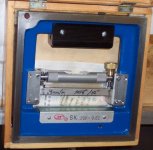David_M
Hot Rolled
- Joined
- Sep 30, 2014
- Location
- Midway, GA, USA
This lathe is cutting with less taper now. I should have done this sooner.
position1.png photo - David photos at pbase.com
position2.png photo - David photos at pbase.com
Has anyone used a granite cuboid/foundation for their lathe(s) to keep things true? I've seen it mentioned somewhere before.
position1.png photo - David photos at pbase.com
position2.png photo - David photos at pbase.com
Has anyone used a granite cuboid/foundation for their lathe(s) to keep things true? I've seen it mentioned somewhere before.


 .
.

